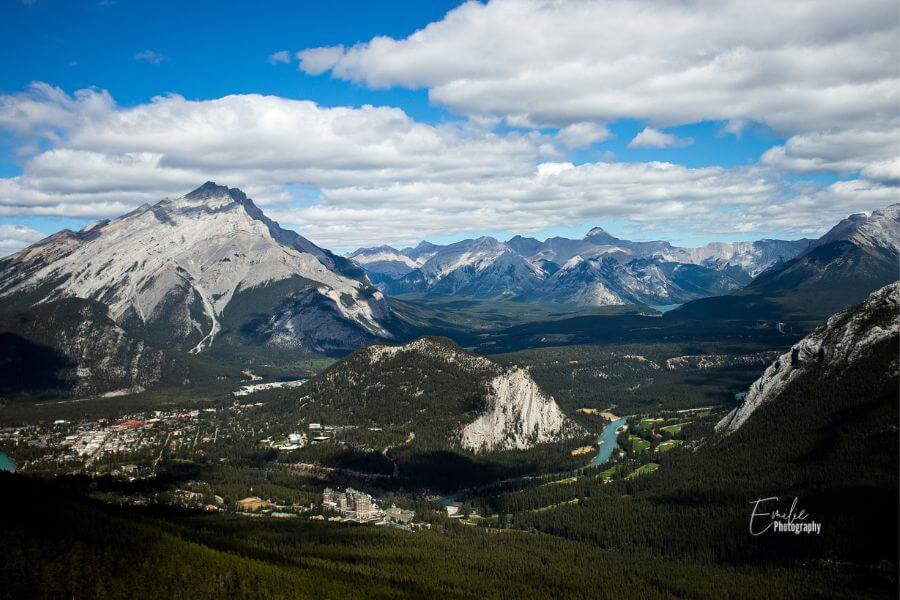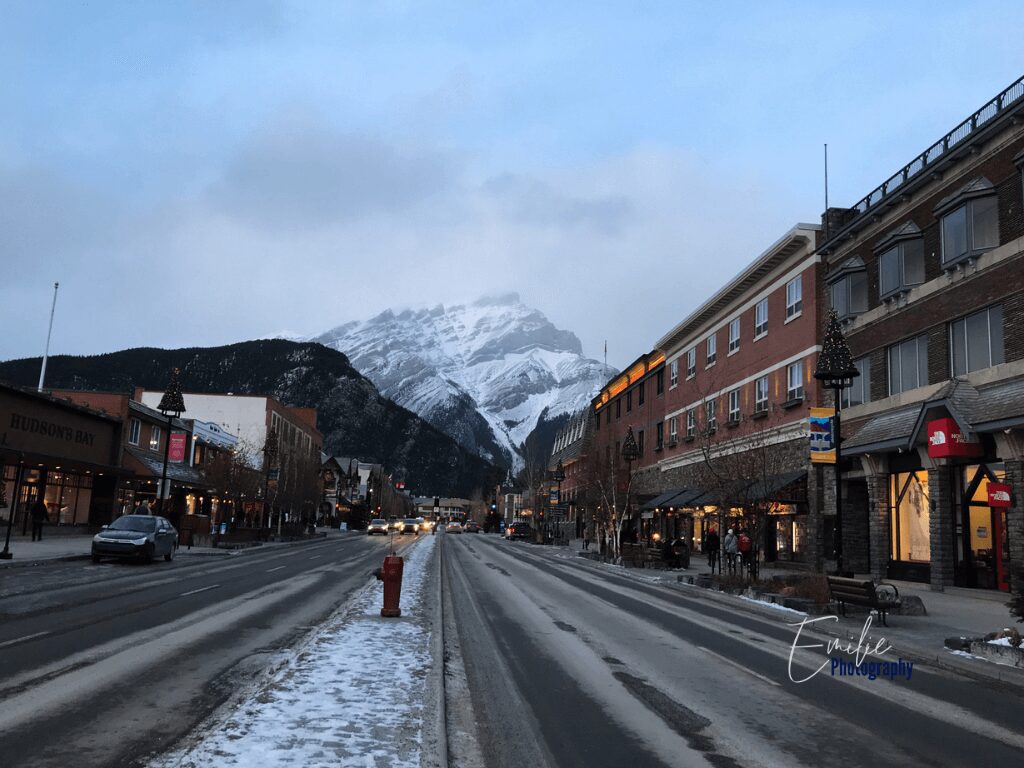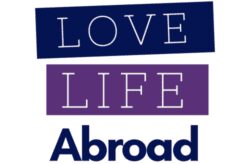Are you wondering when the best time to visit Banff to avoid the crowds? Most people will visit Banff National Park during its peak months, from June through September.
During these months, the park’s iconic and bright turquoise lakes are thawed, and the scenic roads and trails are accessible. Also, the weather is more enjoyable, and there is usually no snow (unless you are in very high altitudes, like on a mountain summit, which is very, very high).
But, several national parks, such as Banff National Park and Glacier National Park, are extremely crowded during summer. And not everyone enjoys walking at a snail’s speed through crowded sidewalks or trails or having many people photo-bombing their Lake Louise picture.
I don’t!
Another thing to consider is that Lake Moraine, a UNESCO World Heritage Site, is open only for a few months, generally from early June through mid-October. During winter, the road to Lake Moraine is closed due to avalanche risks. The only ways to see this iconic lake are:
- Bike when there is no snow,
- Snowshoe or cross-country ski on Lake Moraine Road. It’s around 24 km out and back with 820 m of elevation gain. You can safely cross-country ski or snowshoe up to the Consolation Lakes and Bow Valley viewpoint at about 9 km.
But, if July and August are off the table for a visit to Banff without the crowds, when is it best to visit?
In the article, I’m giving you a month-to-month highlight of Banff to help you decide when to visit. I’m also giving you my favorite month to visit, both for the limited crowds and the amazing things to do.
Disclaimer: Just a heads up, this free article contains affiliate links. If you purchase after clicking one of these links, I may earn a small commission at no additional cost. Also, as an Amazon Associate, I earn from qualifying purchases. Your support helps me continue to provide helpful and free content for you.

Best Time of Year to Visit Banff to Avoid the Crowds
Banff National Park is stunning anytime during the year. Here are some monthly vital points to help you decide what’s best for you and your family and to ensure you avoid the crowds.
That means we’re not recommending a visit to Banff in July and August. There is no way to avoid the crowds unless you go into the backcountry, and it’s a bit trickier with kids.

September
Banff is less crowded and has slightly cooler weather, not winter-like cold. So, like the best of both worlds (less crowds and less heat!).
During this month, the well-known larches start turning yellow, and people visit several locations, like Larch Valley in Lake Moraine, to get their dose of golden. However, this shoulder period also means limited or restricted activities or closed trails.
For example, to promote its cycling experience project, the Bow Valley Parkway closes 17 km on its eastern end to vehicles from September 1st to October 2nd. You can still access Johnston Canyon, don’t worry!

October
It’s pumpkin spice season, or sweater weather, however you wish to call it, in Banff. The temperatures drop even more as we transition from fall to winter. You still get to see some hints of yellow larches as the trees begin to drop their needles.
Ride the Banff Gondola or hike up to Johnston Canyon, as crowds are less observable.
You may need to wear layers as temperatures range from 3 °C to -6 °C. Some roads, like Lake Moraine Road, close for the season, and the lake can no longer be accessed unless you bike, cross-country ski, or snowshoe the distance (roughly 24 km out and back).

November
Known as one of the quietest months, Banff slowly transforms into a winter wonderland, preparing for the ski and ice skating season. Most accommodations offer more affordable rates than during the summer, making this a more budget-friendly period for families to visit.
The frosty weather ambiance with frozen lakes and waterfalls and the promise of a hot chocolate or coffee is enticing. However, if frozen is not your thing (and I’m not talking about the movie here lol), maybe the winter months are not for you.

December
This is the month when you can expect a lot of snow and full winter conditions in Banff National Park. The days are shorter, with the sun rising at around 8:25 am and setting at around 4:38 pm.
The winter sports season is in full swing and blooming. You can expect large crowds in the ski resorts on weekends when most families have time off. If you prefer a calmer experience, try skiing or snowboarding during the week.
This, however, is a beautiful time to stay at a hotel in Downtown Banff and soak in the hot springs. It’s such a contrast between hot and cold!

January, February, and March
During these three months, the weather is cold, and the mountains are almost entirely covered with snow. If winter sports are your thing, these are some of the most perfect months to practice some outdoor activities. You can find beautiful winter hikes.
Also, the days are getting longer, and in March, the sun rises at around 7:25 am and sets at around 6:24 pm, which allows you to enjoy slightly warmer days and “sunbathe” on the snow. This is an actual thing, though, known as windburn, which you know as sunburn, but in wintertime.

April
As spring peeks through the snowy mountain’s window, Banff’s ski season is still on but with more tolerable temperatures anywhere from -6 °C to 12 °C.
The snow is slushy-like in lower altitudes, and after living at -30 °C, it feels like summer!
You can still enjoy skiing, snowboarding, winter hiking, snowshoeing, and cross-country skiing in certain areas where the snow is still present.
May
Some ski resorts like Sunshine Village and Lake Louise Ski Resort remain open for a few more weeks as there’s still snow in higher altitudes.
Lower altitudes benefit from warmer weather, and lakes begin to thaw, which gives you a taste of the majestic turquoise-colored waters that attract visitors to Banff National Park.

June
As the snow is gone and the temperatures keep rising, June feels more like summer during the day. Although it gets chilly at night, it is nothing crazy or intolerable. You can also expect to have some rain.
Lake Moraine Road reopens typically in June. Depending on how much snow is in this area, it can be anywhere from early June to mid-June to even late June.
Therefore, you can expect to see slightly more people.

What to Do in Banff in Every Season: Itinerary Sample
Here’s a more detailed breakdown/itinerary of what to expect and do during different times of the year.
Spring (April – June)
April
Day 1: Ski Day at Kicking Horse Mountain Resort. Start your day with an early breakfast in Banff before embarking on a scenic drive to Kicking Horse Mountain Resort. Enjoy a thrilling day of skiing or snowboarding on the slopes of Kicking Horse, taking in the breathtaking views and challenging terrain. Afterward, unwind at one of the resort’s cozy mountain lodges or restaurants before returning to Banff for the evening.
Day 2: Outdoor Adventures in Banff National Park. Spend your day exploring the diverse wilderness of Banff National Park. Whether you prefer hiking along scenic trails like Cascade Ponds overlooking Cascade Mountain, spotting wildlife in their natural habitat, or cycling through the picturesque landscapes, the park offers a variety of activities to suit every adventurer. Immerse yourself in the park’s natural beauty and create unforgettable memories amidst the majestic Rockies.
Day 3: Cultural Exploration and Relaxation. Delve into the cultural heritage of the area by visiting local museums or art galleries. Learn about the history and culture of the region at places like the Cave & Basin National Site. In the afternoon, treat yourself to a rejuvenating spa experience or enjoy a leisurely stroll along one of the scenic pathways in the town. End your day with a delightful dinner at one of Banff’s renowned restaurants, savoring the region’s flavors.
May
Day 1: Springtime Adventures in Banff National Park. Begin your day by exploring the park’s beautiful landscapes. Rent a canoe or SUP and paddle along the tranquil waters of Two Jack Lake or Vermilion Lakes for impressive views of Mount Rundle and other surrounding mountains. Immerse yourself in the sights and sounds of nature, breathing in the fresh mountain air.
Day 2: Cultural Exploration and Relaxation. Explore the area’s cultural heritage by visiting local museums or art galleries. Visit the Banff Park Museum National Historic Site, where you can explore a collection of 5,000 specimens, or head to the Buffalo Nations Luxton Museum to learn about the rich history and culture of the indigenous peoples of the region.
Day 3: Thrilling Outdoor Activities. Engage in exhilarating outdoor activities such as rock climbing, zip-lining, or mountain biking. Challenge yourself and create unforgettable experiences amidst the stunning scenery of the Rockies. Afterward, unwind with a picnic at Johnson Lake or enjoy a casual lunch at a local eatery, fueling up for more adventures.
June
Day 1: Exploring Downtown Banff. Start your springtime adventure in Banff by exploring the charming downtown area. Visit the Banff Park Museum to learn about the region’s natural history, then stroll down Banff Avenue, stopping at local shops and eateries along the way. Enjoy a leisurely lunch at one of the cozy cafes (we loved Evelyn’s Coffee Bar) before heading to the Banff Gondola for a scenic ride to the top of Sulphur Mountain. From the summit, you’ll be treated to breathtaking views of the surrounding Rockies and Bow Valley. In the evening, unwind with a relaxing soak in the Banff Upper Hot Springs surrounded by stunning mountain scenery.
Day 2: Lake Louise and Moraine Lake. On your second day, explore two of Banff’s most iconic lakes: Lake Louise and Moraine Lake. Start with an early morning visit by taking the shuttle to Lake Louise, where you can admire the turquoise waters and take a leisurely stroll along the shoreline. Then, take another shuttle to Moraine Lake, known for its stunning beauty and crystal-clear waters. Spend the afternoon hiking one of the nearby trails or simply relaxing by the lakeshore. In the evening, enjoy a family-friendly dinner at one of the restaurants in Lake Louise Village before heading back to Banff for the night.
NOTE: Shuttles to Moraine Lake operate from June 1 to October 14, 2024.
Summer (July – September)
Day 1: Lake Minnewanka and Banff Avenue. Kick off your summer getaway in Banff with a visit to Lake Minnewanka, where you can take a scenic boat tour or rent kayaks to explore the sparkling waters. Afterward, head back to Banff and spend the afternoon wandering along Banff Avenue, browsing the shops, and sampling local treats like maple taffy, homemade fudge, and beaver tails. In the evening, dine outside at one of the many outdoor patios, enjoying the warm summer breeze and stunning mountain views.
Day 2: Johnston Canyon, Bow Falls and the Icefields Parkway. Start your second day by hiking to Johnston Canyon, where you can marvel at the towering limestone cliffs and sparkling waterfalls. Don’t miss the chance to walk along the catwalks suspended above the canyon for a unique perspective. You can venture as far as the Ink Pots, a collection of five stunning aquamarine mineral pools nestled in the heart of the wilderness. After your hike, head to Bow Falls for a picnic lunch and some family-friendly fun. In the afternoon, embark on a scenic drive along the Icefields Parkway, one of the most breathtaking routes in the world. As you cruise through the stunning landscapes, make sure to stop at Bow Lake and Peyto Lake to soak in the awe-inspiring views of turquoise waters surrounded by towering mountain peaks. Capture some memorable photos and take a moment to appreciate the natural beauty of Banff National Park. In the evening, treat yourself to a delicious meal at one of Banff’s fine dining establishments, where you can sample gourmet cuisine made with locally sourced ingredients.
Day 3: Thrilling Adventures in the Rockies. Conclude your Banff journey with a day filled with thrilling adventures in the Rockies. Choose from a diverse range of activities such as whitewater rafting on the Kicking Horse River, horseback riding through the backcountry, or taking a scenic helicopter tour of the area. For a more leisurely experience, consider a gentle float trip down the Bow River or a guided nature walk through the lush forests of Banff National Park. As your summer getaway draws to a close, take one last look at the awe-inspiring mountain scenery and start envisioning your next visit to Banff.
Fall (October – November)
Day 1: Discovering the Colors of Fall. Begin your fall adventure in Banff by immersing yourself in the season’s vibrant colors. Take a scenic drive along the Bow Valley Parkway or the Icefields Parkway, where you’ll be treated to breathtaking views of golden aspen trees, larches, snow-capped peaks, and turquoise lakes. Stop at scenic viewpoints along the way for photo opportunities and short hikes to explore the surrounding wilderness. In the evening, cozy up by the fireplace at your accommodation or head to one of Banff’s cozy pubs for a hearty meal and local brew.
Day 2: Hiking in Banff National Park On your second day, lace up your hiking boots and head out to explore the stunning landscapes of Banff National Park. Choose from a variety of trails ranging from easy walks to challenging hikes, all offering panoramic views of the surrounding mountains and valleys. Some popular fall hikes include the Plain of Six Glaciers Trail, the Larch Valley Trail, and the Lake Agnes Tea House Trail. Be sure to bring plenty of layers to stay warm, as the temperatures can vary throughout the day. In the evening, relax and unwind with a soak in the Banff Upper Hot Springs.
Day 3: Wildlife Viewing and Cultural Experiences Spend your final day in Banff exploring the region’s rich wildlife and cultural heritage. Join a guided wildlife tour to spot iconic Canadian animals such as elk, deer, and bighorn sheep in their natural habitat – with any luck you’ll get to see The Boss, Banff’s most dominant grizzly. Then, visit the Whyte Museum of the Canadian Rockies to learn about the history and culture of the area through interactive exhibits and displays. Before you leave, be sure to stroll through the streets of Banff one last time, soaking in the festive atmosphere and vibrant fall colors.
Winter (December – February)
Banff transforms into a winter wonderland.
Day 1: Skiing and Snowboarding. Start your winter adventure in Banff by hitting the slopes at one of the area’s world-class ski resorts. Choose between Mt. Norquay Ski Resort, Sunshine Village Ski Resort, or Lake Louise Ski Resort. Whether you’re a seasoned skier or a first-time snowboarder, you’ll find terrain suitable for all ages and skill levels. Spend the day carving turns down the groomed runs, exploring off-piste powder stashes, or perfecting your tricks in the terrain park. In the evening, warm up with a hot chocolate or mulled wine by the fire at your accommodation, or head into town to sample some hearty Canadian cuisine at one of Banff’s many restaurants.
Day 2: Embrace the Winter Wonderland of Banff. On your second day, step into a winter wonderland in Banff with some outdoor adventures on ice and snow. Lace-up your skates and hit the ice at the Banff Recreation Grounds, where you can glide around under the open sky with stunning mountain views all around. Afterward, head to one of the nearby trails for a snowshoeing excursion through the tranquil winter landscape. Explore snowy forests, frozen lakes, and meandering rivers as you soak in the peaceful beauty of the Rockies in winter. You can also join in the winter festivities, where you’ll discover a host of fun-filled activities tailored for the whole family to enjoy. In the evening, treat yourself to a cozy dinner at a local restaurant, where you can savor hearty comfort food and warm drinks by the fire.
Day 3: Exploring Frozen Waterfalls and Hot Springs. Spend your final day in Banff exploring the frozen wonders of the region. Venture out to Johnston Canyon or Grotto Canyon to see the stunning frozen waterfalls, where you can walk along catwalks suspended above the icy canyon and admire the sparkling ice formations up close. Afterward, warm up with a soak in the Banff Upper Hot Springs, where you can relax in the steamy mineral-rich waters while surrounded by snowy mountain peaks. As you bid farewell to Banff, take one last moment to savor the magic of winter in the Rockies and start dreaming of your next visit!

Final Thoughts: What is the Best Month to Visit Banff?
In my opinion, the best month to visit Banff National Park is September. The summer crowds have thinned out, and the fall colors are in full swing. Plus, most of the park’s attractions remain open and snow-free.
However, just like any national park, you must check Banff National Park’s official website for current conditions, road closures, and any alerts or advisories before planning your trip.
